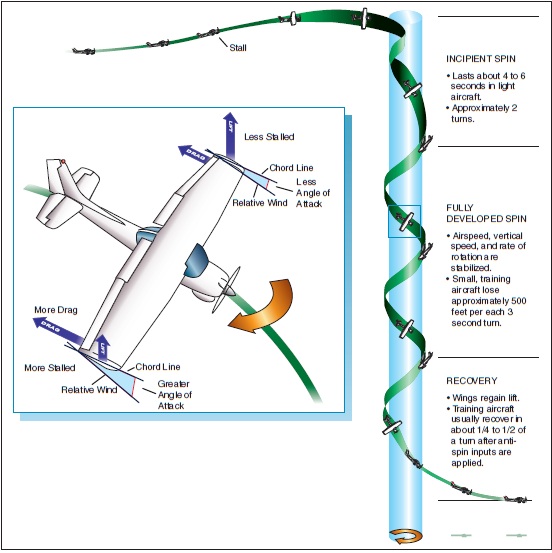
Chapter 4—Slow Flight, Stalls, and Spins
Table of Contents
Introduction
Slow Flight
Flight at Less than Cruise Airspeeds
Flight at Minimum Controllable Airspeed
Stalls
Recognition of Stalls
Fundamentals of Stall Recovery
Use of Ailerons/Rudder in Stall Recovery
Stall Characteristics
Approaches to Stalls (Imminent Stalls)—Power-On or Power-Off
Full Stalls Power-Off
Full Stalls Power-On
Secondary Stall
Accelerated Stalls
Cross-Control Stall
Elevator Trim Stall
Spins
Spin Procedures
Entry Phase
Incipient Phase
Developed Phase
Recovery Phase
Intentional Spins
Weight and Balance Requirements

RECOVERY PHASE
The recovery phase occurs when the angle of attack of the wings decreases below the critical angle of attack and autorotation slows. Then the nose steepens and rotation stops. This phase may last for a quarter turn to several turns.
To recover, control inputs are initiated to disrupt the spin equilibrium by stopping the rotation and stall. To accomplish spin recovery, the manufacturer’s
INCIPIENT SPIN
- Lasts about 4 to 6 seconds in light aircraft.
- Approximately 2 turns.
FULLY DEVELOPED SPIN
- Airspeed, vertical speed, and rate of rotation are stabilized.
- Small, training aircraft lose approximately 500 feet per each 3 second turn.
RECOVERY
- Wings regain lift.
- Training aircraft usually recover in about 1/4 to 1/2 of a turn after antispin inputs are applied.

Figure 4-10. Spin entry and recovery.
recommended procedures should be followed. In the absence of the manufacturer’s recommended spin recovery procedures and techniques, the following spin recovery procedures are recommended.
Step 1—REDUCE THE POWER (THROTTLE) TO IDLE. Power aggravates the spin characteristics. It usually results in a flatter spin attitude and increased rotation rates.
Step 2—POSITION THE AILERONS TO NEUTRAL. Ailerons may have an adverse effect on spin recovery. Aileron control in the direction of the spin may speed up the rate of rotation and delay the recovery. Aileron control opposite the direction of the spin may cause the down aileron to move the wing deeper into the stall and aggravate the situation. The best procedure is to ensure that the ailerons are neutral.
Step 3—APPLY FULL OPPOSITE RUDDER AGAINST THE ROTATION. Make sure that full (against the stop) opposite rudder has been applied.
Step 4—APPLY A POSITIVE AND BRISK, STRAIGHT FORWARD MOVEMENT OF THE ELEVATOR CONTROL FORWARD OF THE NEUTRAL TO BREAK THE STALL. This should be done immediately after full rudder application. The forceful movement of the elevator will decrease the excessive angle of attack and break the stall. The controls should be held firmly in this position. When the stall is “broken,” the spinning will stop.
Step 5—AFTER SPIN ROTATION STOPS, NEUTRALIZE THE RUDDER. If the rudder is not neutralized at this time, the ensuing increased airspeed acting upon a deflected rudder will cause a yawing or skidding effect.
Slow and overly cautious control movements during spin recovery must be avoided. In certain cases it has been found that such movements result in the airplane continuing to spin indefinitely, even with anti-spin inputs. A brisk and positive technique, on the other hand, results in a more positive spin recovery.
Step 6—BEGIN APPLYING BACK-ELEVATOR PRESSURE TO RAISE THE NOSE TO LEVEL FLIGHT. Caution must be used not to apply excessive back-elevator pressure after the rotation stops. Excessive back-elevator pressure can cause a secondary stall and result in another spin. Care should be taken not to exceed the “G” load limits and airspeed limitations during recovery. If the flaps and/or retractable landing gear are extended prior to the spin, they should be retracted as soon as possible after spin entry.
It is important to remember that the above spin recovery procedures and techniques are recommended for use only in the absence of the manufacturer’s procedures. Before any pilot attempts to begin spin training, that pilot must be familiar with the procedures provided by the manufacturer for spin recovery.
The most common problems in spin recovery include pilot confusion as to the direction of spin rotation and whether the maneuver is a spin versus spiral. If the airspeed is increasing, the airplane is no longer in a spin but in a spiral. In a spin, the airplane is stalled. The indicated airspeed, therefore, should reflect stall speed.
PED Publication